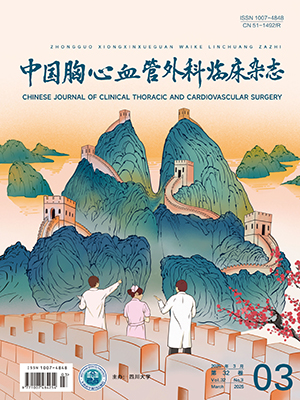| 1. |
Saeyeldin AA, Velasquez CA, Mahmood SUB, et al. Thoracic aortic aneurysm: Unlocking the "silent killer" secrets. Gen Thorac Cardiovasc Surg, 2019, 67(1): 1-11.
|
| 2. |
Sharples L, Sastry P, Freeman C, et al. Aneurysm growth, survival, and quality of life in untreated thoracic aortic aneurysms: The effective treatments for thoracic aortic aneurysms study. Eur Heart J, 2022, 43(25): 2356-2369.
|
| 3. |
Milewicz DM, Ramirez F. Therapies for thoracic aortic aneurysms and acute aortic dissections. Arterioscler Thromb Vasc Biol, 2019, 39(2): 126-136.
|
| 4. |
Shen M, Quertermous T, Fischbein MP, et al. Generation of vascular smooth muscle cells from induced pluripotent stem cells: Methods, applications, and considerations. Circ Res, 2021, 128(5): 670-686.
|
| 5. |
Stratman AN, Burns MC, Farrelly OM, et al. Chemokine mediated signalling within arteries promotes vascular smooth muscle cell recruitment. Commun Biol, 2020, 3(1): 734.
|
| 6. |
Chen Y, Zhang T, Yao F, et al. Dysregulation of interaction between LOXhigh fibroblast and smooth muscle cells contributes to the pathogenesis of aortic dissection. Theranostics, 2022, 12(2): 910-928.
|
| 7. |
Kobylecki CJ, Nordestgaard BG, Afzal S. Plasma ionized calcium and risk of cardiovascular disease: 106 774 individuals from the Copenhagen general population study. Clin Chem, 2021, 67(1): 265-275.
|
| 8. |
Choudhury RP, Akbar N. Beyond diabetes: A relationship between cardiovascular outcomes and glycaemic index. Cardiovasc Res, 2021, 117(8): e97-e98.
|
| 9. |
Zhu Y, Qu J, He L, et al. Calcium in vascular smooth muscle cell elasticity and adhesion: Novel insights into the mechanism of action. Front Physiol, 2019, 10: 852.
|
| 10. |
Patel K, Zafar MA, Ziganshin BA, et al. Diabetes mellitus: Is it protective against aneurysm? A narrative review. Cardiology, 2018, 141(2): 107-122.
|
| 11. |
Arun D, Munir W, Schmitt LV, et al. Exploring the correlation and protective role of diabetes mellitus in aortic aneurysm disease. Front Cardiovasc Med, 2021, 8: 769343.
|
| 12. |
Vignac M, Ntika S, Olsson C, et al. Metformin therapy is not associated with the lower prevalence of ascending aortic aneurysm in diabetic patients. Eur J Cardiothorac Surg, 2022, 61(2): 388-392.
|
| 13. |
高明妃, 胡如英. 中国糖尿病死亡流行特征研究进展. 预防医学, 2022, 34(7): 692-695.Gao MF, Hu RY. Research progress on epidemiological characteristics of death of diabetes in China. Prev Med, 2022, 34(7): 692-695.
|
| 14. |
Daly A, Hovorka R. Technology in the management of type 2 diabetes: Present status and future prospects. Diabetes Obes Metab, 2021, 23(8): 1722-1732.
|
| 15. |
Dall TM, Yang W, Gillespie K, et al. The economic burden of elevated blood glucose levels in 2017: Diagnosed and undiagnosed diabetes, gestational diabetes mellitus, and prediabetes. Diabetes Care, 2019, 42(9): 1661-1668.
|
| 16. |
Can A, Rudy RF, Castro VM, et al. Low serum calcium and magnesium levels and rupture of intracranial aneurysms. Stroke, 2018, 49(7): 1747-1750.
|
| 17. |
Roman MJ, Devereux RB, Kramer-Fox R, et al. Two-dimensional echocardiographic aortic root dimensions in normal children and adults. Am J Cardiol, 1989, 64(8): 507-512.
|
| 18. |
王洪岩. 急性主动脉夹层患者的入院血钠和血糖对其短期预后的影响. 华北理工大学, 2021.Wang HY. Influence of admission serum sodium and serum glucose on short-term prognosis of patients with acute aortic dissection. North China University of Science and Technology, 2021.
|
| 19. |
Kim JB, Spotnitz M, Lindsay ME, et al. Risk of aortic dissection in the moderately dilated ascending aorta. J Am Coll Cardiol, 2016, 68(11): 1209-1219.
|
| 20. |
Akin I, Nienaber CA. Prediction of aortic dissection. Heart, 2020, 106(12): 870-871.
|
| 21. |
Ganapathi AM, Ranney DN, Peterson MD, et al. Location of aortic enlargement and risk of type A dissection at smaller diameters. J Am Coll Cardiol, 2022, 79(19): 1890-1897.
|
| 22. |
Galan A, Barcelona PF, Nedev H, et al. Subconjunctival delivery of p75NTR antagonists reduces the inflammatory, vascular, and neurodegenerative pathologies of diabetic retinopathy. Invest Ophthalmol Vis Sci, 2017, 58(7): 2852-2862.
|
| 23. |
Watson EC, Grant ZL, Coultas L. Endothelial cell apoptosis in angiogenesis and vessel regression. Cell Mol Life Sci, 2017, 74(24): 4387-4403.
|
| 24. |
Zhou S, Huang G, Huang H. Extraction, derivatization and antioxidant activities of onion polysaccharide. Food Chem, 2022, 388: 133000.
|
| 25. |
Qi K, Xia G, Huang G, et al. Extraction, chemical modification, and antioxidant activities of Daucus carota polysaccharide. Chem Biol Drug Des, 2021, 98(6): 1098-1103.
|
| 26. |
阿依加马丽·加怕尔, 巴哈依定·吾甫尔. 胡萝卜的功能特性及食品应用研究进展. 现代园艺, 2013, 5(3): 11-12.Ayigamali Gabor, Bahayiding Wufuer. Research progress on functional characteristics and food applications of carrots. Mod Horticul, 2013, 5(3): 11-12.
|
| 27. |
Tosello F, Guala A, D'ascenzo F, et al. Central pulse pressure is inversely associated with proximal aortic remodelling. J Hypertens, 2021, 39(5): 919-925.
|
| 28. |
Lam CS, Xanthakis V, Sullivan LM, et al. Aortic root remodeling over the adult life course: Longitudinal data from the Framingham Heart Study. Circulation, 2010, 122(9): 884-890.
|
| 29. |
Yin ZQ, Han H, Yan X, et al. Research progress on the pathogenesis of aortic dissection. Curr Probl Cardiol, 2022: 101249.
|
| 30. |
李根, 刘达兴. 急性主动脉夹层发生机制的病理生理学研究进展. 海南医学, 2022, 9: 69-71.Li G, Liu DX. Progress in pathophysiology of acute aortic dissection. Hainan Med, 2022, 9: 69-71.
|
| 31. |
Tankeu AT, Ndip Agbor V, Noubiap JJ. Calcium supplementation and cardiovascular risk: A rising concern. J Clin Hypertens (Greenwich), 2017, 19(6): 640-646.
|
| 32. |
Yang Y, Chen W, Wen N, et al. Benidipine, an anti-hypertensive drug, relaxes mouse airway smooth muscle. Life Sci, 2019, 227: 74-81.
|
| 33. |
Cheng J, Wen J, Wang N, et al. Ion channels and vascular diseases. Arterioscler Thromb Vasc Biol, 2019, 39(5): e146-e156.
|
| 34. |
Dungan KM, Braithwaite SS, Preiser JC. Stress hyperglycaemia. Lancet, 2009, 373(9677): 1798-1807.
|




